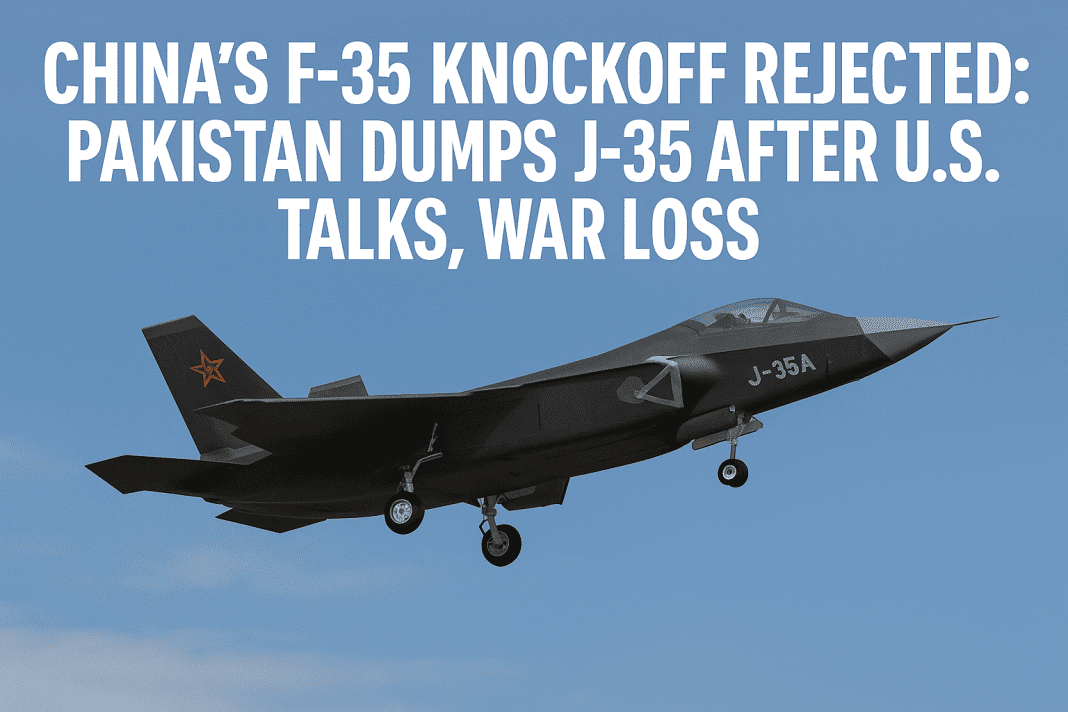In a dramatic geopolitical twist, Pakistan has abruptly pulled out of a $5 billion deal with China to acquire the Shenyang J-35, a stealth fighter often described as China’s version of the F-35.
Pakistan’s Sudden Exit from J-35 Deal Shocks Beijing
The reversal comes after the recent four-day conflict with India, where Pakistan fielded Chinese-made weapons that failed to perform.
Despite years of defense ties with Beijing, Pakistan’s government has officially denied any plans to buy the J-35. This comes after Pakistani pilots were photographed training on the aircraft in 2024 and senior officials previously confirmed ongoing negotiations.
“We are not buying the J-35. It’s just media talk,” Pakistan’s Defence Minister said on live TV.
Battlefield Reality: China’s Weapons Fall Flat
The decision appears tied directly to the results of India’s Operation Sindoor, which exposed serious weaknesses in Chinese equipment. During the war, Pakistan deployed Chinese JF-17 jets, HQ-9 air defense systems, and CH-4 drones. These systems were easily overpowered by India’s homegrown arsenal, including the BrahMos missile, Akash air defense, and Rafale fighters.
Jet Black Threat: Pakistan’s J-35 Fighters Could Turn India’s Airspace into a No-Fly Zone
Military analysts say China’s weapons lost the credibility test. In contrast, India’s technology, developed under the “Make in India” and “Atmanirbhar Bharat” doctrines, delivered a decisive edge.
This outcome may have forced Islamabad to rethink its dependence on Chinese platforms.
U.S. Talks, New Strategy: Why Pakistan Flipped
The timing of Pakistan’s reversal is equally revealing. Just weeks before the announcement, top military leaders from Pakistan visited the White House, Pentagon, and State Department. President Donald Trump called Pakistan’s army chief “really impressive” and praised his role in preventing a nuclear escalation with India.
Behind closed doors, U.S. officials reportedly offered Pakistan access to F-16 Block 70s, HIMARS artillery, and advanced missile systems. Soon after, Pakistan also avoided a major export tariff in a U.S.-Pakistan trade negotiation round.
The strategic shift seems clear. Pakistan may be ditching Chinese jets not just because of poor performance — but to win American defense tech and economic relief.
Blow to China’s Defense Dreams
China’s J-35 was promoted as its most advanced export fighter, boasting stealth features, twin engines, and long-range missile capabilities. Beijing hoped the J-35 would challenge American dominance and help keep India occupied on two fronts.
China Enters the Next Era of Naval Power as Reports Suggest J-35B EMALS Launch from Fujian
Now, with Pakistan out, China’s jet may face international embarrassment. Defense experts say China may have tried to sweeten the deal with discounts, but failed to restore confidence after the weapons’ underwhelming combat debut.
The U.S. State Department hasn’t officially commented on the J-35 fallout. But analysts agree — Washington’s win is Beijing’s loss.

